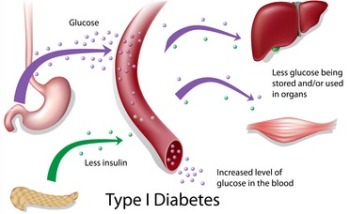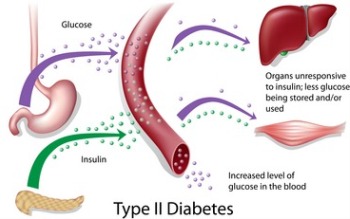Feline Diabetes
Types and Causes
There are two types of feline diabetes - Diabetes Mellitus (sugar diabetes) and Diabetes Insipidus.
The two cat diseases should not be confused.
Whilst they may bear the same name and often present with similar
symptoms, the two diseases are very different.
feline diabetes mellitus
This disease is commonly called sugar diabetes. It is a disease that affects the endocrine system (name given to the glands that control or produce hormones) and is a complex, but fairly common disease in cats.
In short, it is a condition where the cat is unable to regulate or control its blood glucose (i.e. blood sugar).
This is due to the body either not utilizing the insulin it produces or the body not producing sufficient insulin.
The result of this is an abnormally high blood sugar level.
Simply put - in a healthy cat, food is ingested and thereafter digestion takes place. Glucose (sugar) then enters the blood stream.
In response to this, the pancreas will release the hormone insulin. Insulin regulates the metabolism of fats and carbohydrates and assists the muscle, fat and liver tissue to take up the blood glucose.
Essentially insulin allows the cells to utilize the glucose for energy. No insulin = no glucose utilization = hyperglycemia
types of cat diabetes mellitus
type I
This cat diabetes is also referred to as insulin-dependent diabetes.
It is caused by the pancreas producing and secreting inadequate amounts of the hormone insulin.
As the body is unable to take up glucose from the blood, insulin needs to be provided either in the form of tablets or injections.
Cat
diabetes affects up to 3 in 1000 cats. Type-I diabetes is the most
common and accounts for about 80 % of the cases of diabetes in cats.

type II
This form of the disease is characterized by the body's cells having an inadequate response to the insulin that is being produced.
Type II cat diabetes is non-insulin dependent.
The Type-II diabetic cat will rely on
a diabetic diet to control this form of feline diabetes - (i.e. low
calorie; high fibre diet).

causes of cat sugar diabetes
The cause of feline diabetes mellitus is largely unknown and not clearly understood. Most experts do agree that there are a number of predisposing factors that may be responsible for causing the disease:
predisposing factors
genetics
Certain cat breeds e.g. some Burmese cats appear to have a higher incidence of developing feline diabetes.
obesity
An overweight cat is more likely to develop cat diabetes.

an obese cat is prone to diabetes
sex
Male cats appear to have a higher propensity for developing cat diabetes.
age
Diabetes is more common (and on the rise) in geriatric cats or cats over 7 years of age.
hormonal imbalances
due to acromegaly (pituitary gland produces excess growth hormone); hyperthyroidism (thyroid gland produces excess thyroid hormones) and Cushing's Syndrome (body exposed to high levels of the hormone cortisol).
drugs
The long term or continued use of certain medication can affect the pancreas and reduce the production of insulin. Corticosteroids (cortisone) for treating inflammation amongst other conditions may also cause pancreatitis and affect the production of insulin.
pancreatic disease
i.e. tumors, pancreatitis, viral and bacterial infections
symptoms | treatment
It is critical to identify feline diabetes symptoms early on and to seek the advice of a veterinary practitioner for an accurate diagnosis.
Take a look at the chapter on cat diabetes treatment and its prognosis.
why the pancreas is important
The pancreas is an endocrine gland situated in the upper abdomen and located next to the liver, duodenum and stomach.
The pancreas has the following functions:
- To produce enzymes that assists with the digestion of food.
- The beta cells in the pancreas produce insulin. Insulin is a hormone that assists the cells of the body to utilize glucose thereby regulating blood sugar - insulin regulates high glucose levels.
- Glucagon is also produced by the pancreas and this hormone also regulates blood glucose levels - glucagon is released when the blood sugar is too low.
With this in mind, it stands to reason that any major damage to the pancreas that results in an over or under production of insulin or glucagon may result in life-threatening cat illnesses.
diabetes insipidus | a definition
The anti-diuretic hormone (ADH), also known as vasopressin, is produced in the hypothalamus of the brain and stored in the pituitary gland.
In diabetes insipidus the pituitary gland fails to secrete the anti-diuretic hormone, vasopressin and this results in the kidneys not being able to conserve water or controlling the concentration of urine.
In certain instances, it may also result from the kidneys for some reason not reacting to the hormone vasopressin.
The kidneys are responsible for eliminating waste products by filtering the blood.
A
failure of removal of waste from the body can be fatal to the health of
the cat, but can be treated successfully. Diabetes Insipidus is a rare
cat disease.
To Top of Page
search our site
please like us
share our site
recommend on google
favorite pages





